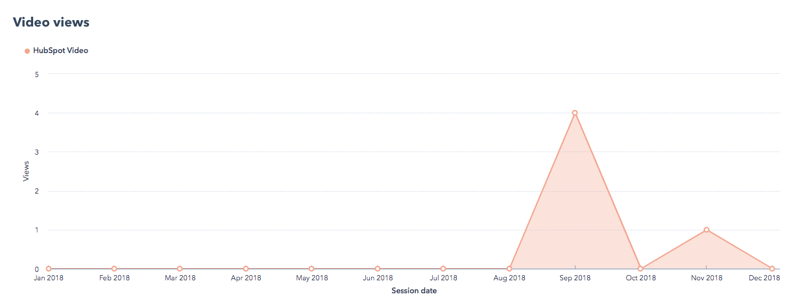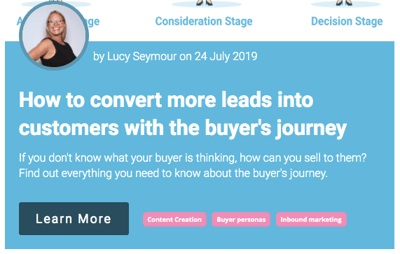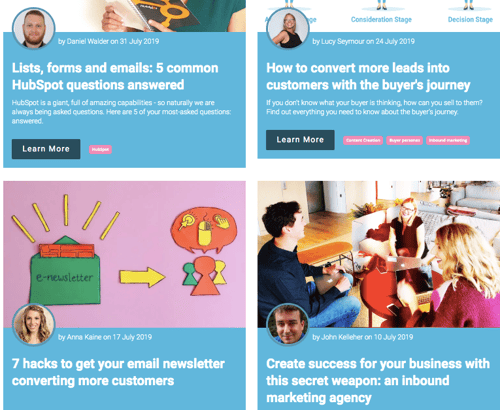Your blog is a vital component of your marketing strategy. But over time, maintaining your blog – keeping it relevant, helpful, attractive and useable – can become more complex.
Our customers ask us what they can do make blogging for business a more worthwhile exercise, so their readers can get the most out of it as a resource. As with many things, the answer is usually to simplify.
These are some of the questions customers ask us about improving their blogs (as well as some of our favourite tips) so you can banish the clutter and create a more beautiful user journey on your blog.
Tip 1: Add videos to your blog
Using video in your blog is a great idea. When you’re blogging for business, attracting prospects through video not only shows the faces and voices behind your company, but makes it easier and quicker for users to get the information they need.
One of our customers recently asked us how to make the most of video on their blog:
“I’d like to be able to see how much of each video on our blog users are watching – how do I do this?”
HubSpot is integrated with VidYard, making it extra easy for you to upload and track your videos. Not only does it mean you can add CTAs and forms over the top of your video, but within your HubSpot portal, you can monitor how much of a video contacts have viewed.

Getting an idea of a video’s overall performance through video views and video retention helps you plan for future content creation, and consider the ROI of your video production.
Tip 2: Check broken links
Broken links on your site are a big no-no. It can be a frustrating experience for visitors who are trying to navigate to your other pages (potentially to make a purchase), but find they can’t because you haven’t updated a link. But broken links present other dangers, too.
Our Director of Content, Lucy Seymour, explains:
“If customers don’t get a smooth user experience on your blog, they might lose faith in your ability to deliver other services and products, too. Broken links look sloppy.
You could also be damaging your SEO – Google reviews links and collects data about each page. They will be less likely to display your content on SERPs if you aren’t linking to the things you say you are.”
Conduct a sweep of your website to find broken links by using a tool such as Screaming Frog or Dr Link Check.
Tip 3: Avoid cut-off sentences
Writing a description that appears in its entirety on your blog homepage is great blogging for business practice. You don’t want to leave visitors guessing what the post might be about, so here’s how to avoid dreaded unfinished sentences...
One of our customers emailed us with this concern:
“The intro copy on the main blog page cuts off, even mid word. Ideally we would have a separate text box (rather than the introduction automatically uploaded from the post) with a set number of maximum characters – is this possible?”
Crafting an enticing introduction (not just automatically uploading the start of the blog post) is highly recommended. To alter the number of characters that display, a small amount of HTML coding should do the trick. We recommend switching from the default number to around 150-200 characters to allow for a snappy, yet descriptive introduction.

In HubSpot, you can pre-set your meta description – ESM Inbound's is set to 155 characters – so you can plan your description copy within the character count, banishing cut-off sentences for good.
Tip 4: Clean your email list
When subscribers sign up, are they actually opening the email, and are they clicking through to the posts? This information matters. And if you aren’t monitoring it and cleaning your email list, there’s an important reason why you should.
In HubSpot, this is a small box you can check in your email editor, meaning these potentially harmful contacts won't be sent mail.
Tip 5: Neaten up your navigation and social links
The structure of your post – where each element sits on the page and how things connect together – is really important. If icons click to the wrong location, or its hard to navigate your content, readers just won’t persevere with your blog.
One of our customers wanted to know:
“We need an easier way for readers to find our posts by theme on our blog, any ideas? Also our logo links to the wrong page – how can we fix these links to be tidier and correct?”
Ease of use is one of the most important things you can invest in on your blog. We recommend inserting a search bar, as well as adopting a library style format. This means that users will navigate your posts by topic, not necessarily by newness (though we suggest leading with your most recent blog post at the top).
Social links must lead to the correct platforms, and your logo should always link back to your homepage – it’s the anchor users need to rely on, no matter how deep into your website they get. Check these links today, and re-set them if necessary, to avoid frustrating your visitor.
Tip 6: Watch out for feature image repeats
While we’d like to think blogging for business is all about the knowledge we share, a lot of your blog’s success comes down to its appearance. As Conversion XL explains, 'It takes about 50 milliseconds (ms) (that’s 0.05 seconds) for users to form an opinion about your website that determines whether they’ll stay or leave.' What are you doing to make your images, and use of colour and space, as attractive as possible?
Try these tips for smartening up your use of images:
- Keep featured images relevant to the blog post – don’t make anything obscure or open to interpretation. With users making their minds up so quickly about whether a post is worth reading, this is a time to be literal.
- You might have some favourite shots, but if you overuse these your readers will soon grow desensitised to them (and it could make you look small fry). Don't use the same images time and again.
- Try using a design agency if you don’t have in-house designers to create fun graphics, or experiment with your own photography instead of stock images."
Before you publish each new blog post, look at the featured image grid on your blog page. Check the image you've selected for your most recent post isn't the same as any already live on the blog.
Tip 7: Vary your contributors
You might only have a small content team, where one copywriter does the majority of the content creation – but your readership wants to hear advice from across your business. Keeping the authors varied, and tackling a range of topics is key to a successful business blog.
Lucy Seymour, Director of Content, explains one of ESM Inbound’s approaches:
“We appreciate that everyone at our agency has a different skill set and can offer useful advice across a range of topics. So we speak to each other, setting up interviews between trained writers and other team members to get the best content to our readers.
We also feature guest bloggers – such as customers or HubSpot team members – to mix up the tone of voice and offer real, usable tips from across the industry.”

If your blogging budget is small, at least try to reach out to team members or external experts for a quote to use on your blog – this can be a great opportunity for link-building, too. If you ask for a quote and link from a competitor, you can offer them a quote and link in return for their blog.
Tip 8: Organise your tags and categories
Since Google changed its search algorithm, we’ve all had to get a lot more organised with the way we categorise our content. We now need to make it super clear what our content is about, and link it to other similar content, creating a map for search engines to follow.
Our Director of Growth, John Kelleher, explains why it’s so important to use blog tags:
“Once you click ‘publish’, your blog posts are released, untethered into the ether of the internet. By adding a topic tag – and just one – to your blog posts, you are informing Google about the subject of the post, helping searchers find it.
Additionally, every blog post you publish should be linked to a relevant pillar page. The HubSpot SEO tool is really handy for seeing where your keyword gaps are, and which posts are still ‘floating’ around without a hub to link to.”
Try to action these tips regularly, rather than letting them build up over time, so they become less of a chore and more of a good-practice habit. Remember above all that your blog should cater to your readership to provide a user-friendly experience. Look at your blog through their eyes and work out how easy it is to use, and how attractive it is to look at. Only by empathising with your visitors can you grow your subscriptions and turn your blog into a lead-generation tool.
Stay Updated with Our Latest Insights
Get expert HubSpot tips and integration strategies delivered to your inbox.

.jpg)


